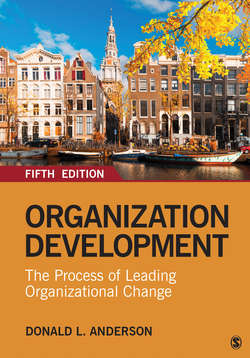Читать книгу Organization Development - Donald L. Anderson - Страница 70
На сайте Литреса книга снята с продажи.
Lewin’s Three-Phase Model of Change and Force Field Analysis
ОглавлениеKurt Lewin (1951) offered a three-phase model of organizational change in which he described change as a process of (1) unfreezing, (2) moving, and (3) refreezing. Current organizational practices need to be released (or unfrozen) to be changed. Once they are changed, they need to be refrozen as newly adopted regular practices. Lewin pointed out that two forces worked together to maintain equilibrium in an organization: forces promoting a change and forces promoting the status quo. Change can occur only when forces of change are greater than forces maintaining the status quo. This can happen in two ways: if forces promoting change are increased or forces maintaining the status quo are decreased.
For example, imagine that a company is going to introduce a new financial software system. Forces supporting the change might be that (1) the new system will permit a more sophisticated analysis of the company’s financial results, (2) the new system will be more accurate than the current system, and (3) the system can be integrated into the current contracts and manufacturing systems. Forces resisting the change might be (1) the need for extensive employee training, (2) the cost of implementing the system, and (3) the reluctance on the part of employees who have had a bad experience with similar implementations. Lewin’s model points out that change will not occur if the training, cost, and resistance are greater than the benefits that the system offers (see Figure 4.2).
Lewin’s is an easily grasped description of change that has been widely adopted by managers and practitioners. It explains that to embrace something new, something else must be left behind. The organization must be freed from prior practices and must work to sustain the change when it is implemented. The model also reminds us that organizational members must be prepared for a change, and that levels of resistance can mean that the organization remains in a frozen state until we work to unfreeze it. Members must be practically or symbolically released from previous practices in order to change them, and following a change, conscious attention must be paid to reinforcing the change in order to help it stick. A popular adaptation of Lewin’s model refers to an organization’s current state, a transition state, and a desired state (Beckhard & Harris, 1977). Despite its popularity among practitioners, many scholars have noted that an “organization-as-ice-cube” model is, however, an oversimplification of a much more complex process, particularly since organizational practices are never exactly frozen (Kanter, Stein, & Jick, 1992).
Figure 4.2 Kurt Lewin’s Force Field Analysis
Lewin’s concept of force field analysis has become a useful tool for OD practitioners to use with clients. The tool can help organizational members understand what factors would support a given change effort and what resistance might prevent the change from being adopted. Some practitioners use the model as a formal assessment, asking team members (separately or in groups) to rate the strength of the forces for and against change on a scale from 1 to 5 to prioritize actions where energy should be directed (see Schwering, 2003, for a variation on this approach).
